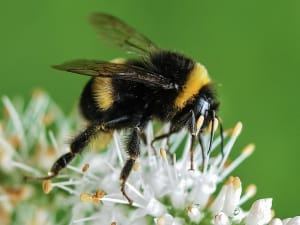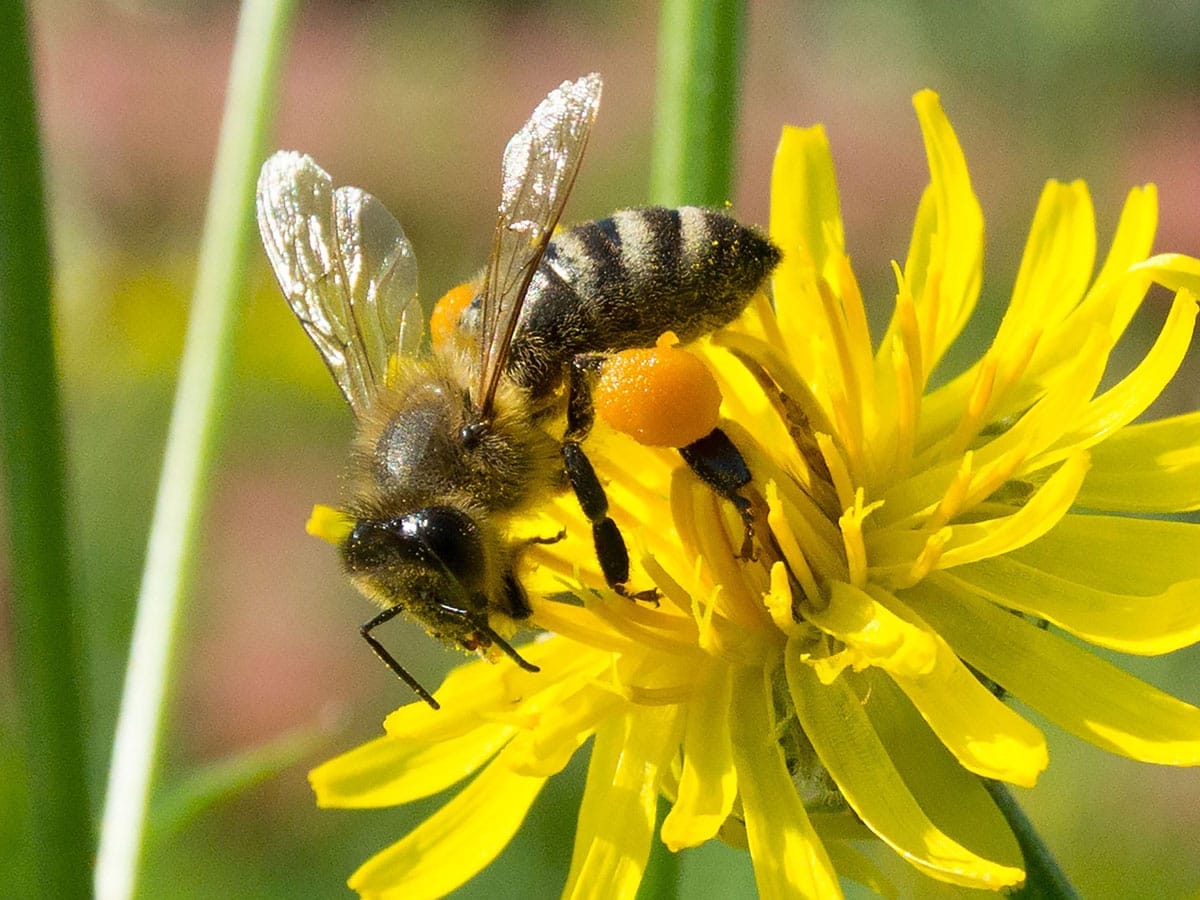Spirit Animals: BUSY BEE
There is a plethora of beautiful information available about the general qualities of bee symbolism such as fertility, communication, hard work, rewards, etc. For some variety, I’m going to give a more detailed look at lesser known aspects of bee symbology and biology.
Bee Symbolism of the Hive
There are only seven species of honey bee, which is a very small portion (0.04%) of the 20,000 bee species on earth. We know the honey bee best because they are the only domesticated bees. The honey bee’s close relationship with humans spans over millennia. This likely explains why most associations we have with bee symbolism are actually attributes that are specific to the honey bee.
When we think of bees, we think of the hive. Naturally, bee spiritual meaning is paired with the idea of community. Honey bees do have incredibly large hives with 50,000 to 60,000 individuals. These massive hives, made of beeswax and formed into a hexagonal matrix, are storehouses for excessive amounts of honey. Humans have harvested this honey since the time of early Egyptian and Greek civilizations.

Bumble bee – Fat, furry with blocks of color rather than stripes.
However, the thousands of other species of bees that exist do not congregate in such numbers. Nor do other species of bees produce elaborate hives and a surplus of honey. Is it smart to look at the largest city in a country (say New York) and think that everyone in that country (USA) lives the same way?
Bumble bees, for example, live in groups of 50-400 bees and create a small nest. They only produce the amount of honey they need to feed themselves and their young.
So when thinking of bees, yes think of cooperation, community, and production. But, there’s no need to think that if we have a bee animal totem that we need to join the masses. When a community becomes too large it becomes a crowd in which we can get lost. Bee symbolism reminds us to be mindful of our tendency to escape into the swarm. Bee totem animal encourages us towards genuine connections with others.
For fun, let’s take a closer look at how to tell the honey bee apart from the bumble bee (the photo at the very top of this post is a honey bee).
HONEY BEE
- Slender, narrow build
- Pointed body at stinger
- Many thin stripes on the abdomen
- Moderately hairy
- Only feed on open flowers
- Mostly domesticated
- Hives of 50,000-60,000
- 7 species
BUMBLE BEE
- Fat, broad build
- Rounded body at stinger
- Larger blocks of color
- Very furry
- Can feed on different flower shapes
- Always wild
- Nests of 50-400
- 250 species
The Eusociality of Bee Spirit Animal
The word “Eusocial” means the highest order of social organization. Many species of bee, including the honey and bumble bee, are eusocial. This means that they tend to young as a group, have many generations working together, and practice division of labor into reproductive and non-reproductive adults. The division of labor is also known as a “caste system”. There’s a queen bee, worker bees and drones.
Bee spirit animal challenges us to accept the roles we have in life. There is a value to dividing up labor and having a job description. There’s a security and a freedom in that. When we embrace the work we have to do in our lives and really put ourselves into it, we can truly benefit the whole. Of course, the downside of this is when we go numb to the routine of life. The bee totem animal can help us find the joy and the creativity in playing our discrete roles. By not being everything to everybody or not being the queen bee, we can specialize, focus on the work at hand, and be really good at what we do.
The Sting of Bee Animal Totem
Ever heard that bees die after they sting? This is only true of honey bees. When they sting animals with thick skin (such as humans) their barbed stinger gets caught in the skin. Part of their inner organs ruptures out of their bodies as they pull away from the stuck stinger. The venom sac continues to pump toxin into our bodies after the bee flies away and dies. Other bees, including bumble bees, have straight stingers that don’t become lodged in skin, so they can sting repeatedly.
When we get angry we can attack someone again and again. We may also become attached to the person and rupture our energetic systems. This causes us to pour way too much of our own energy into making the offender pay. Like the bee, we may feel compelled to go back to the hive and rally the swarm to join in on the attack.
We all have the potential to harm others. No matter how much we say we won’t harm another creature, we still snap at our spouses or tell the telemarketer to take a hike.
The majority of bee species are known for using the sting as a last resort. They retreat whenever they can. Bee teaches us to watch carefully how easily we are offended. We can ask bee spirit animal for the wisdom to strike back only when it is necessary for our protection. The honey bee reminds us to watch carefully afterwards to be sure we aren’t rupturing valuable energy into the situation long after it is over.
How Pollen Baskets Influence Bee Spiritual Meaning
We are told that bees pollinate flowers by picking up pollen on one flower and carrying it to another flower. It sounds like an accident that the pollen is just brushed onto the bee’s legs and they just happen to carry it elsewhere. Female worker bees intentionally collect pollen. It is a valuable protein and fat resource for them and the young.
The pollen is carried in “pollen baskets” which are dish-shaped indentations on their back legs that are surrounded by a basket of hairs. The workers rub the pollen off their bodies and pack it into their baskets. You can see the bright yellow-orange globs on the back legs of the honey bee in the photo at the top of this post. That is all pollen.
Bees also harvest nectar and carry it back to the nest in their bellies. They regurgitate it upon return which creates honey.
Harvesting and carrying resources is a huge aspect of bee symbolism.
Like the bee, travel far and wide seeking out the richness of life. Gather it up. Pack it into your soul and swallow it into your belly. Then feel the hum of the hive, of your community, calling you home. Bring back the harvest. Share it with others. And get up the next day to do it all over again.
References:
http://www.myrmecos.net/2011/10/11/how-to-tell-the-difference-between-honey-bees-and-bumble-bees/
https://bumblebeeconservation.org/about-bees/faqs/honeybees-vs-bumblebees/
https://en.wikipedia.org/wiki/Bee
Want to learn more about spirit animals?
Visit the Spirit Animal Guide




I had a huge Bumble Bee just sat on my window, the first one I have seen this year, and then your email came through. Funnily enough before I’d read your article I was talking to my friend about “connections” to others. I feel this is something I need to look at. I knew straight away when I saw the bee there was some sort of message for me.
Thank you for the info. I love how information comes to us and the timing is always perfect.
That is so fun Jude! Thank you for sharing! It is awesome how guidance can come in such synchronous ways. What fortune that you are able to dance with the timing of it all. Many Blessings, Stacey
I just had a dream about a bumble bee last night. Can’t remember much other than him flying around outside by our back porch. I had no idea he could be called upon as an animal spirit guide. I do wonder at times if I have multiple animal spirit guides though, as I’ve dreamt of several different animals. Not sure whether they all apply as a means to spiritual transformation or not. Thanks for the article, nonetheless. It was an interesting read.
You’re most welcome Mason and YES! We most definitely can have more than one spirit animal. If you haven’t seen them yet, you might find this series of videos helpful: https://www.youtube.com/watch?v=8Por74bEq4I&index=1&list=PLSn4p-l7AkLSf2wfdEn-L2-AeU_RyvOSl. Many Blessings, Stacey
Subscribe